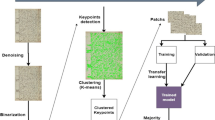Abstract
Recent renewed interest in computational writer identification has resulted in an increased number of publications. In relation to historical musicology its application has so far been limited. One of the obstacles seems to be that the clarity of the images from the scans available for computational analysis is often not sufficient. In this paper, the use of the Hinge feature is proposed to avoid segmentation and staff-line removal for effective feature extraction from low quality scans. The use of an auto encoder in Hinge feature space is suggested as an alternative to staff-line removal by image processing, and their performance is compared. The result of the experiment shows an accuracy of 87 % for the dataset containing 84 writers’ samples, and superiority of our segmentation and staff-line removal free approach. Practical analysis on Bach’s autograph manuscript of the Well-Tempered Clavier II (Additional MS. 35021 in the British Library, London) is also presented and the extensive applicability of our approach is demonstrated.












Similar content being viewed by others
Notes
It is often the case that libraries do not allow us to return to source.
Javis [9] claims to have conducted his research this way. However, his application was not sufficiently transparent.
See http://www.cs.waikato.ac.nz/ml/weka for more information about Weka. Normalised poly kernel was used as the kernel function of SVM and sequential minimal optimisation was conducted [15]. The number of trees was set to 100 for RF.
Franklin’s classification is considered [7] . This conclusion was not based on handwriting analysis but the studies on paper, rastral and the diplomatic features of the score.
References
Bulacu M, Schomaker L (2007) Text-independent writer identification and verification using textural and allographic features. IEEE Transactions on Pattern Analysis and Machine Intelligence 29(4):701–17
Dadelsen Gv (1958) Beiträge zur Chronologie der Werke Johann Sebastian Bachs. Tübinger Bach-Studien, vol. 4–5, Trossingen, Hohner
Dalitz C, Droettboom M, Pranzas B, Fujinaga I (2008) A comparative study of staff removal algorithms. IEEE Transactions on Pattern Analysis and Machine Intelligence 30(5):753–766
Dürr A (1957) Zur Chronologie der Leipziger Vokalwerke J. S. Bachs. Bach-Jahrbuch 44:5–162
Fornés A, Dutta A, Gordo A, Lladós J (2011) The ICDAR 2011 music scores competition: staff removal and writer identification. In: Proceedings of International Conference on Document Analysis and Recognition, pp 1511–1515. IEEE
Fraley C, Raftery AE (2000) Model-based clustering, discriminant analysis, and density estimation. J Am Stat Assoc 97:611–631
Franklin DO (1989) Reconstructing the Urpartitur for WTC II: a study of the ‘London Autograph’. In: Bach Studies, pp. 240–77. Cambridge University Press, Cambridge, UK
Hinton GE, Salakhutdinov RR (2006) Reducing the dimensionality of data with neural networks. Science 313(5786):504–507
Jarvis M (2007) Did Johann Sebastian Bach write the six cello suites? Ph.D. thesis, Charles Darwin University
Kobayashi Y, Beißwenger K (2007) Die Kopisten Johann Sebastian Bachs : Katalog und Dokumentation, Kassel, Bärenreiter
Maarse F (1987) The study of handwriting movement: Peripheral models and signal processing techniques, Ph.D. thesis, University of Nijmegen
Maarse F, Schomaker L, Teulings HL (1988) Automatic Identification of Writers. In: van der GC, Mulder G (eds) HumanComputer Interaction: Psychonomic Aspects. Springer, New York, pp 353–360
Niitsuma M, Tomita Y, Yan W, Bell D (2011) Classifying Bach’s Handwritten C-clefs. In: Proceedings of 12th International Conference on Music Information Retrieval, pp. 417–421
Otsu N (1975) A threshold selection method from gray-level histograms. IEEE Transactions on Systems Man, and Cybernetics 11(1):285–296
Platt JC (1999) Fast training of support vector machines using sequential minimal optimization. In: Schölkopf B, Burges CJC, Smola AJ (eds) Advances in kernel methods. MIT Press, pp 185–208
Schomaker L (2007) Advances in Writer Identification and Verification. In: Proceedings of Ninth International Conference on Document Analysis and Recognition (ICDAR 2007), vol. 2, pp. 1268–1273. IEEE
Schomaker L, Bulacu M, Franke K (2004) Automatic writer identification using fragmented connected-component contours
Spitta P Johann Sebastian Bach. Leipzig: Breitkopf und Härtel, 2 vols. (1873–1880)
Author information
Authors and Affiliations
Corresponding author
Rights and permissions
About this article
Cite this article
Niitsuma, M., Schomaker, L., Oosten, JP.v. et al. Musicologist-driven writer identification in early music manuscripts. Multimed Tools Appl 75, 6463–6479 (2016). https://doi.org/10.1007/s11042-015-2583-8
Received:
Revised:
Accepted:
Published:
Issue Date:
DOI: https://doi.org/10.1007/s11042-015-2583-8




